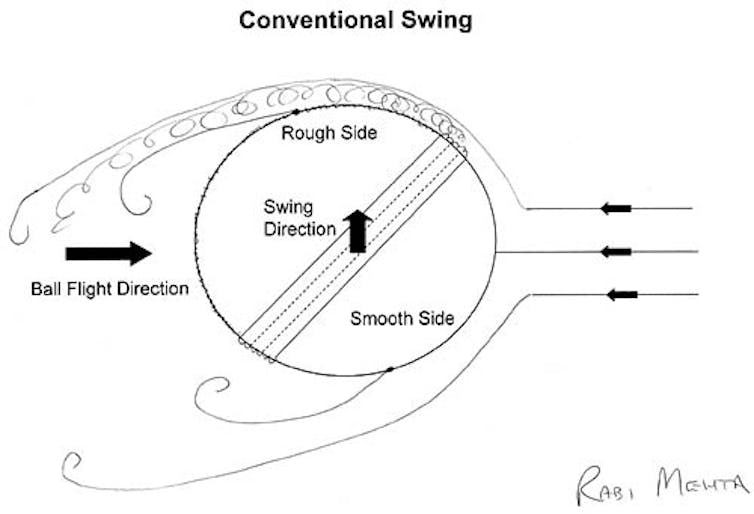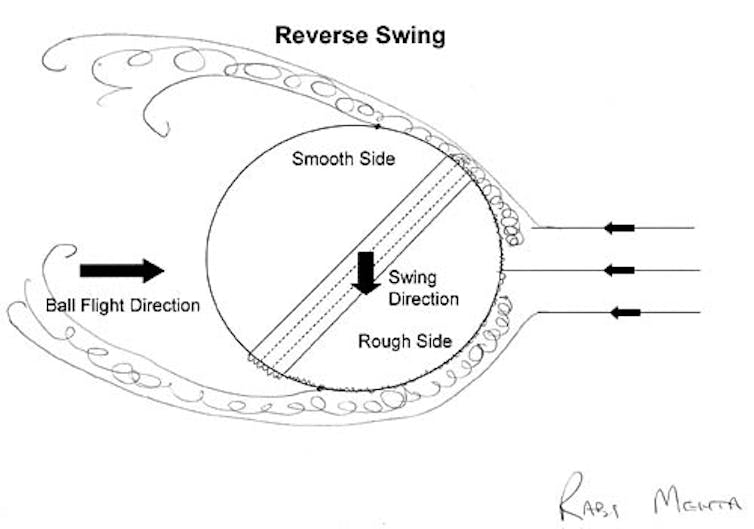Cricket is supposed to be the epitome of sporting integrity. But in recent days, the actions of the Australian cricket team have brought the “dark arts” of the game to the forefront of many people’s minds and their actions have drawn condemnation from around the world.
To understand why the players tried to tamper with the ball – and how they did it – it’s worth exploring the technique of what is called “swing bowling”. Swing bowling essentially involves being able to change the direction of the ball in mid-air. There are two types of swing to explore here: “conventional” and “reverse” swing.
To begin with, a cricket ball’s design means that it can be optimised by the bowler to make it swing. A cricket ball has a core of cork and is covered by a leather casing with a slightly raised seam sewn in. The equator of the cricket ball is stitched with string to form the seam. On either side of the seam, the surface of the ball will degrade with use. The fielding side will usually allow one side to roughen up, while trying to keep the other side shiny.
As NASA scientist and cricket enthusiast Ravindra Mehta explained in a detailed paper in 2000, for a cricket ball to “swing” – or move sideways through the air as it moves forward towards the batsman – there needs to be a different speed of airflow on either side of the ball to help produce a lateral force on one side. This can be done by using the seam or surface of the ball. Once the cricket ball is bowled a thin layer of air forms around its surface – this is the “boundary layer”. This boundary layer does not stay attached to the surface all the way around and so it has to separate at a certain point on the ball. This separation point will affect how the ball moves further through the air. A late separation will lead to lower pressure on that side and a net lateral force will be generated if there is a pressure difference between the two sides, making the ball move sideways.
The boundary layer can have two states: one of these is a relatively stable “laminar” state, or a more variable and disordered “turbulent” state. Going from a laminar to turbulent state will occur at a critical speed – and this is determined by the roughness of the cricket ball surface. More roughness means that the critical speed can be lower.
Conventional swing
The typical way to create swing is to use the seam and the asymmetry of the ball. Bowlers will angle the seam away from the intended direction of travel so the shiny side of the ball faces the batsman. The ball will swing towards the direction that the seam is pointed – if the seam is angled toward the slip fielders it will swing away the batsman (outswinger) and if the seam is angled towards the leg side it will swing into the batsman (inswinger).
When the ball is bowled with the seam at an angle, the boundary layer on top of the ball is affected by the seam and goes into a turbulent state earlier than the bottom – this leads to later separation from the ball which creates a pressure difference and thereby a lateral force allowing the ball to swing in the direction of the seam. Using this type of approach of angling the seam typically works best (creates the most lateral force) around 70 mph – which is about slow to medium pace in international cricket.

To maximise this effect, teams polish the ball between deliveries and this is where we encounter the first area of potential ball tampering. Having a polished leading side (towards the batsman) is important so that side has a laminar separation once in flight – but there have been accusations in the past of teams using products such as Vaseline or mints to aid this polishing. Indeed, the current South African caption, Faf Du Plessis, was found guilty of ball tampering after appearing to suck a mint before applying his saliva to aid shining the ball during a test match against Australia in 2016. Typically, as a ball becomes older it becomes harder to produce this swing and that is where we encounter the next type of swing – reverse swing.
Reverse swing
If a player can bowl above 85mph – or if the ball has aged – this makes it possible for the bowler to “reverse swing” the ball. In simple terms this is exactly what happens – a delivery that is expected to swing away from the batter (an outswinger), instead swings in towards them (an inswinger) – and vice versa. This happens when the seam is angled for conventional swing but this time the rough side faces the batsman. If the ball is bowled fast enough (above 85 mph), the laminar layer goes into a turbulent state before it reaches the seam. The seam actually has a negative effect here and affects the turbulent layer so it separates earlier compared with the bottom surface.

Like in conventional swing, there is a lateral force created because of the pressure difference but this time the lateral force acts in the opposite (reversed) direction. As mentioned, there is a critical speed to help generate reverse swing but in cases where this speed can’t be reached, the roughness of the ball can help reduce this critical speed needed to create this reverse swing.
As the ball gets older (which means the surface is rougher) it becomes easier to deliver balls with reverse swing. The fact that more roughness makes it easier to create reverse swing introduces the temptation for players to increase this roughness illegally and thereby make it easier to generate reverse swing at lower speeds.
The Australian case
There are many instances of alleged and proven ball tampering in cricket down through the years from stamping on the ball, to picking at the seam of the ball to even biting the ball. The Australians have admitted that during the recent test against South Africa they used sticky tape in their pocket covered with debris collected from the pitch to make a sort of improvised sandpaper to further roughen up the ball. This means that they could potentially generate reverse swing at lower speeds.
What makes this case so controversial is how obvious and blatant it was, along with the admission apparently being premeditated in the lunch break. Obviously, tampering with the ball can unfairly advantage the bowling team and goes completely against the spirit of the game.

